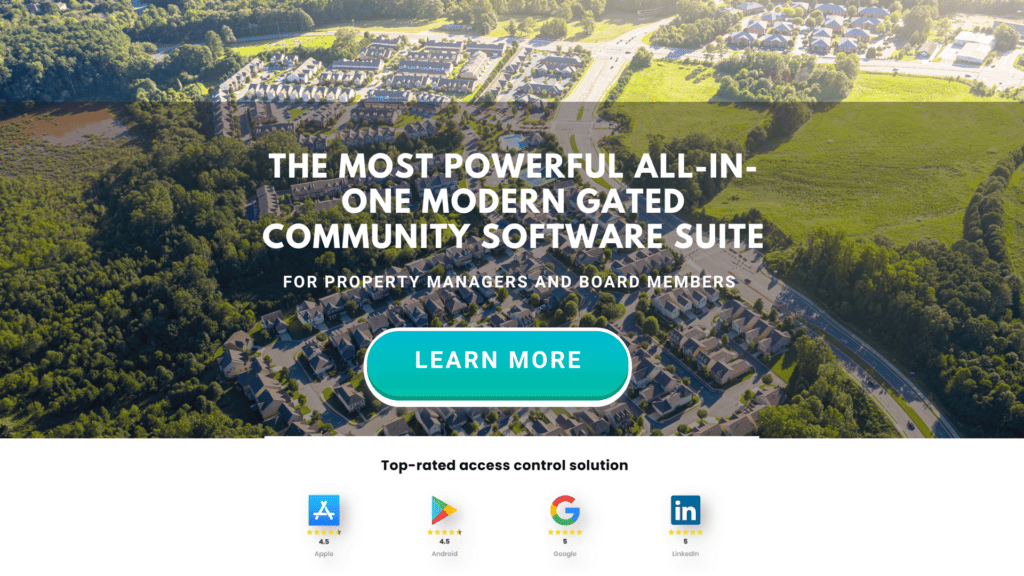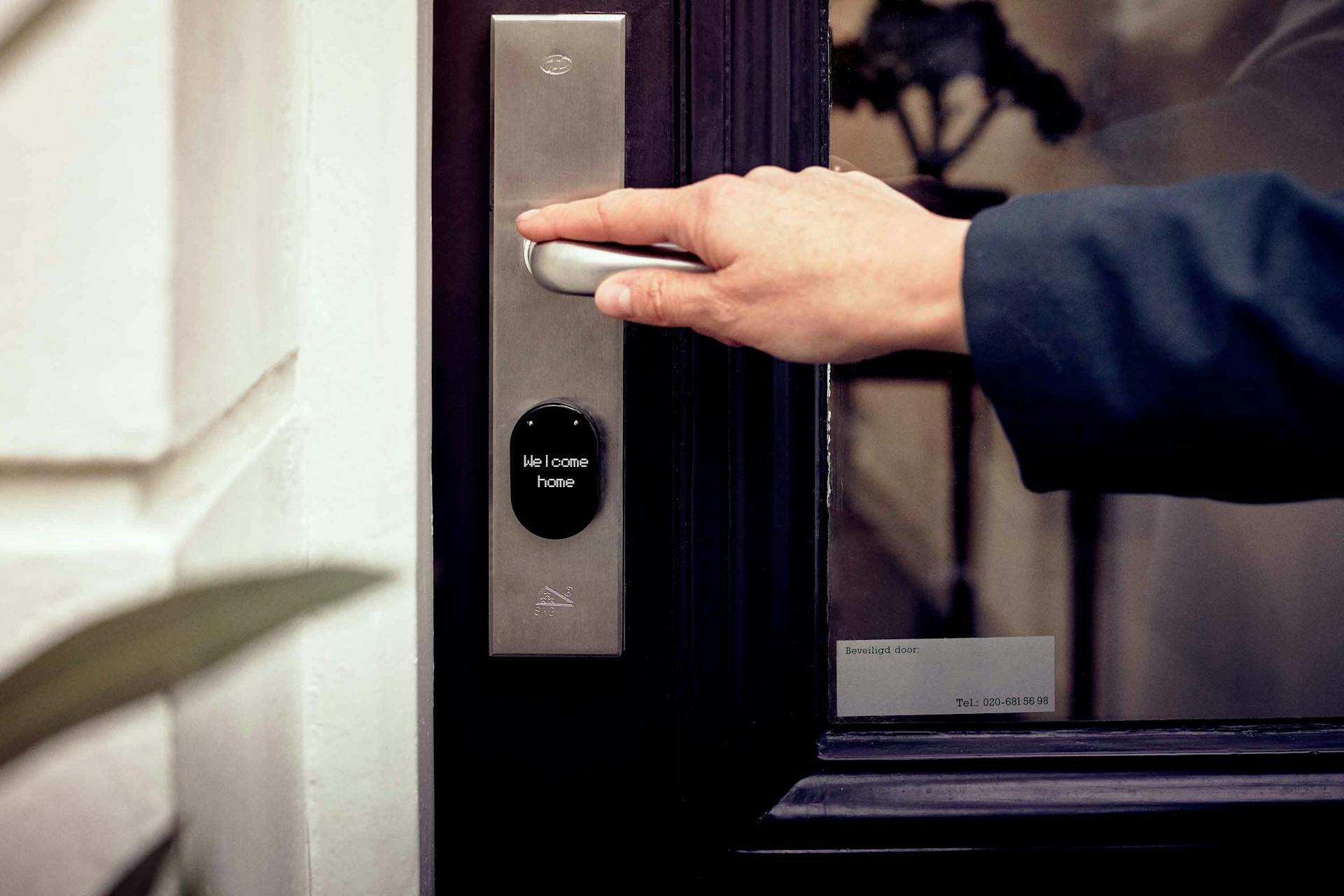Controlling access in shared communities, multi-residence buildings, and clubs can be challenging, especially when it comes to balancing security with seamless entry for residents, members, and visitors.
Bluetooth access systems offer property managers and security committees a robust, user-friendly solution tailored to larger, multi-occupant environments.
In this guide, we’ll explore how Bluetooth door access, combined with advanced technologies like License Plate Recognition (LPR) and virtual guarding, is revolutionizing access management for modern communities.
IN THIS ARTICLE
- What is Bluetooth Door Access?
- Benefits of Bluetooth Door Access for Shared Communities
- Integrating Bluetooth Door Access with LPR Systems
- How Virtual Guarding Complements Bluetooth Door Access
- Implementing Bluetooth Door Access in HOAs and Multi-Residence Buildings
- Best Practices for Bluetooth Door Access Implementation
- Future Trends in Access Management
- Conclusion
What is Bluetooth Door Access?
Bluetooth door access is an innovative access control technology that enables residents, members, and authorized individuals to unlock doors using Bluetooth-enabled devices (typically smartphones).
Unlike traditional keys, fobs, or access cards, Bluetooth door access relies on secure, encrypted Bluetooth connections to verify identities and grant entry. This technology offers a secure, convenient way for residents, staff, and guests to access main entrances, gated areas, shared facilities, and standard rooms without physical keys.
Bluetooth-enabled access systems allow property managers to grant or revoke access instantly and remotely, simplifying visitor management and boosting security. This system is particularly beneficial for residential gate access control systems in shared communities, reducing the burden of key management and preventing unauthorized entry.
Benefits of Bluetooth Door Access for Shared Communities
Bluetooth door access systems are rapidly gaining popularity in shared communities, buildings, and clubs due to their range of advantages:
1. Enhanced Security and Access Control
Bluetooth door access control systems use secure, encrypted connections that are challenging to duplicate or hack, offering higher security than traditional keys or fobs.
With Bluetooth access, property managers can monitor entry logs and remotely adjust access permissions, providing more control over who enters and exits the property at any time.
2. Convenience for Residents and Managers
For residents and members, Bluetooth removes the hassle of managing physical keys or cards—entry is just a tap away on a smartphone.
For property managers, it simplifies access management. New residents, maintenance staff, or authorized visitors can be granted access instantly without needing in-person key handoffs or extra hardware.
3. Cost and Maintenance Savings
Traditional key-based systems require significant upkeep, especially if keys are lost, or residents move frequently. With Bluetooth, maintenance costs are minimal as the system operates digitally. Property managers also benefit from reduced expenses for issuing and replacing keys or access cards.
Many Bluetooth systems integrate seamlessly with virtual security guard setups, reducing the need for on-site personnel.
4. Integration with Advanced Security Technologies
Bluetooth door access integrates effectively with other security systems like License Plate Recognition (LPR) and virtual guard software. Combining these technologies creates a comprehensive security framework that covers both pedestrian and vehicle access, which is especially beneficial in larger communities, buildings, and clubs.
 Integrating Bluetooth Door Access with LPR Systems
Integrating Bluetooth Door Access with LPR Systems
An LPR or License Plate Recognition system uses cameras and software to capture vehicle license plate data and manage access at gated entrances. This system works well alongside Bluetooth door access, enabling property managers to secure pedestrian and vehicle entrances using a cohesive, tech-enabled approach.
Enhancing Gate Access with License Plate LPR
With License Plate Recognition (LPR) technology at vehicle entry points, communities can implement secure gate access that allows quick and convenient entry for residents and members. The LPR system automatically recognizes and logs the license plates of registered vehicles, granting access only to approved plates.
This automatic license plate recognition system minimizes delays at entrances, allowing authorized vehicles to enter seamlessly.
Integrating Bluetooth door access with LPR gate access offers a consistent user experience. Residents can drive through the gate with their registered plate and access other areas using Bluetooth on their smartphones.
This combined setup offers increased control over all access points, and property managers can monitor both vehicle and pedestrian entries in real time for added security.
Gate Access LPR for Visitor Management
Managing visitor access is critical in shared communities, and combining Bluetooth door access with LPR visitor access provides a streamlined solution. Property managers can pre-approve visitors and grant them temporary access via license plates.
When a visitor arrives, the automatic license plate recognition system identifies the approved vehicle, opening the gate without manual intervention.
Once inside, Bluetooth door access can allow visitors to access authorized areas, such as standard rooms or recreational facilities. This integrated approach provides a complete vehicle and individual access record, enhancing security and improving visitor convenience.
How Virtual Guarding Complements Bluetooth Door Access
Virtual guarding has become a popular option in larger communities and buildings where continuous on-site personnel might not be feasible. Virtual security guard systems provide remote monitoring and quick response capabilities, supplementing Bluetooth door access and LPR systems.
Virtual Security Guard Systems
Virtual security guard systems integrate with on-site security equipment like cameras and access control systems, allowing a remote security team to monitor multiple entry points. When Bluetooth door access and LPR gate access are part of the setup, virtual guard software can track every entry and alert property managers if unauthorized access is attempted.
With a virtual security guard, communities and buildings can enjoy high security without extensive on-site personnel. Virtual guards can take immediate action, such as locking doors, alerting authorities, or communicating with the intruder through speakers if necessary.
Using Virtual Guard Software for Comprehensive Monitoring
Virtual guard software offers security personnel a centralized platform to monitor multiple properties or access points. Integrated with Bluetooth door access and LPR systems, this software provides a comprehensive view of all entry points, enabling security teams to respond quickly if issues arise. Real-time monitoring means that security personnel can intervene as necessary without requiring an in-person response.
Implementing Bluetooth Door Access in HOAs and Multi-Residence Buildings
Bluetooth door access is flexible and suitable for different communities, clubs, and buildings. Bluetooth access can be implemented at gated communities’ entry points and common areas, while LPR systems secure vehicle gates.
Common areas like gyms, lounges, or pools can also be equipped with Bluetooth access, providing residents with secure, easy-to-use entry throughout the property.
Residential gate entry systems that combine Bluetooth access and automatic license plate recognition provide a seamless experience for residents and guests. Property managers can control the system, review access logs, and make real-time adjustments to ensure everyone’s access needs are met without compromising security.
Best Practices for Bluetooth Door Access Implementation
To successfully implement the system in shared residential spaces, it’s helpful to follow these best practices:
1. Conduct a Comprehensive Security Audit
Start by assessing your current security setup and access control needs. Review high-traffic areas, entry points, and shared spaces to determine where Bluetooth and LPR systems would be most effective.
2. Choose Compatible Systems and Software
Ensure the Bluetooth system integrates well with other security features, like LPR systems and virtual guard software. A unified approach simplifies management and provides comprehensive coverage.
3. Educate Residents and Staff
Provide a user-friendly guide on how to use Bluetooth door access and LPR systems. Clear instructions help residents adjust to the new system and understand its benefits.
4. Establish Clear Access Protocols
Set clear rules for granting and revoking access to ensure consistency. Temporary visitor passes, emergency protocols and secure visitor access settings are essential for effective access control.
5. Review and Update Regularly
Update access settings periodically to account for residents moving in or out and ensure that access permissions are current. Regular updates help prevent unauthorized access and enhance overall security.
Future Trends in Access Management
Access management is evolving, and innovations in Bluetooth, LPR systems, and virtual guarding are likely to shape future practices:
AI-Enhanced LPR Systems
Automatic license plate recognition systems are expected to incorporate AI to improve recognition accuracy and adapt to different settings.
Biometric Integration
Integrating biometrics with Bluetooth door access, like facial recognition, can offer additional security for communities and buildings.
Advanced Virtual Guard Software
As virtual guard software evolves, features like predictive analytics and automated responses may become standard, further enhancing remote monitoring.
These advancements will continue to enhance access management, making it easier for HOAs and property managers to maintain a secure, streamlined environment.
Conclusion
When combined with LPR systems and virtual guarding, Bluetooth access creates a comprehensive access management solution ideal for shared communities, buildings, and clubs. Property managers benefit from seamless access control, improved security, and increased convenience for residents and members.
Implementing Bluetooth door access, automatic license plate recognition, and virtual security guard software can help communities create a safe, efficient, and welcoming environment.
Contact us for more insights on Bluetooth and LPR access solutions and to learn how these technologies can transform your community’s security.

